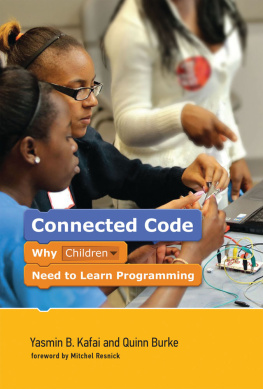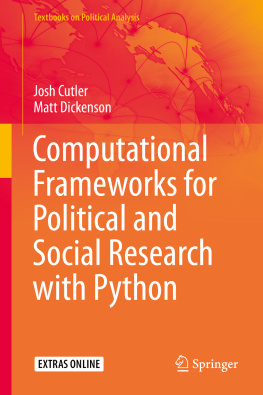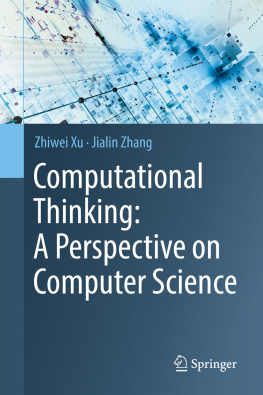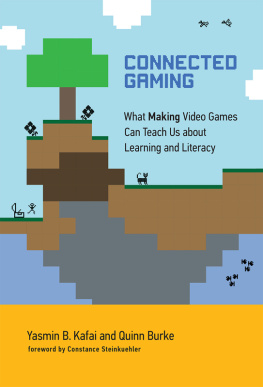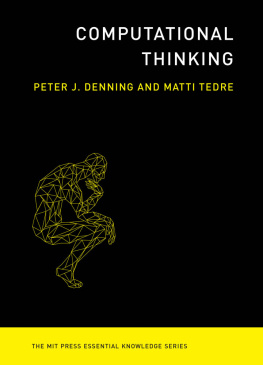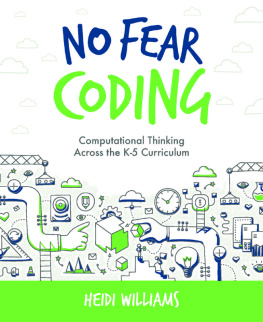Connected Code
The John D. and Catherine T. MacArthur Foundation Series on Digital Media and Learning
Engineering Play: A Cultural History of Children's Software, by Mizuko Ito
Hanging Out, Messing Around, and Geeking Out: Kids Living and Learning with New Media, by Mizuko Ito, Sonja Baumer, Matteo Bittanti, danah boyd, Rachel Cody, Becky Herr-Stephenson, Heather A. Horst, Patricia G. Lange, Dilan Mahendran, Katynka Martnez, C. J. Pascoe, Dan Perkel, Laura Robinson, Christo Sims, Lisa Tripp, with contributions by Judd Antin, Megan Finn, Arthur Law, Annie Manion, Sarai Mitnick, David Schlossberg, and Sarita Yardi
The Civic Web: Young People, the Internet, and Civic Participation, by Shakuntala Banaji and David Buckingham
Connected Play: Tweens in a Virtual World, by Yasmin B. Kafai and Deborah A. Fields
The Digital Youth Network: Cultivating New Media Citizenship in Urban Communities, edited by Brigid Barron, Kimberley Gomez, Nichole Pinkard, and Caitlin K. Martin
Connected Code: Why Children Need to Learn Programming, by Yasmin B. Kafai and Quinn Burke
The Interconnections Collection: Understanding Systems through Digital Design, developed by Kylie Peppler, Melissa Gresalfi, Katie Salen Tekinba, and Rafi Santo
Gaming the System: Designing with Gamestar Mechanic, by Katie Salen Tekinba, Melissa Gresalfi, Kylie Peppler, and Rafi Santo
Script Changers: Digital Storytelling with Scratch, by Kylie Peppler, Rafi Santo, Melissa Gresalfi, and Katie Salen Tekinba
Short Circuits: Crafting E-Puppets with DIY Electronics, by Kylie Peppler, Katie Salen Tekinba, Melissa Gresalfi, and Rafi Santo
Soft Circuits: Crafting E-Fashion with DIY Electronics, by Kylie Peppler, Melissa Gresalfi, Katie Salen Tekinba, and Rafi Santo
Inaugural Series Volumes
Six edited volumes were created through an interactive community review process and published online and in print in December 2007. They are the precursors to the peer-reviewed monographs in the series. For more information on these volumes, visit http://mitpress.mit.edu/books/series/john-d-and-catherine-t-macarthur-foundation-series-digital-media-and-learning.
Connected Code
Why Children Need to Learn Programming
Yasmin B. Kafai and Quinn Burke
The MIT Press
Cambridge, Massachusetts
London, England
2014 Massachusetts Institute of Technology
All rights reserved. No part of this book may be reproduced in any form by any electronic or mechanical means (including photocopying, recording, or information storage and retrieval) without permission in writing from the publisher.
MIT Press books may be purchased at special quantity discounts for business or sales promotional use. For information, please email special_sales@mitpress.mit.edu.
This book was set in Stone by the MIT Press. Printed and bound in the United States of America.
Library of Congress Cataloging-in-Publication Data
Kafai, Yasmin B.
Connected code : why children need to learn programming / Yasmin B. Kafai and Quinn Burke.
pages cm. (The John D. and Catherine T. Macarthur foundation series on digital media and learning)
Includes bibliographical references and index.
ISBN 978-0-262-02775-5 (hardcover : alk. paper)
ISBN 978-0-262-31925-6 (retail e-book)
1. Computers and children. 2. Computer programmingStudy and teaching (Secondary) 3. Scratch (Computer program language) 4. Constructivism (Education) I. Burke, Quinn, 1976 II. Title.
QA76.9.C659K34 2014
004.083dc23
2014003658
10 9 8 7 6 5 4 3 2 1
To Seymour and for Nyla
Series Foreword
Digital media and networks have become embedded in our everyday lives and are part of how we engage in knowledge production, communication, and creative expression. Unlike the early years of computers and computer-based media, digital media are now commonplace and pervasive. Digital media have escaped the boundaries of professional and formal practice and the academic, governmental, and industry homes that initially fostered their development and have been taken up by diverse populations and noninstitutionalized practices, including the peer activities of youth. Although forms of technology uptake are diverse, a generation is growing up in an era when digital media are part of the taken-for-granted social and cultural fabric of learning, play, and social communication.
This book series is founded on the working hypothesis that those immersed in new digital tools and networks are engaged in an unprecedented exploration of language, games, social interaction, problem solving, and self-directed activity that leads to diverse forms of learning. These diverse forms of learning are reflected in expressions of identity, independence, and creativity and an ability to learn, exercise judgment, and think systematically.
The defining frame for this series is not a particular theoretical or disciplinary approach or a fixed set of topics. Rather, the series revolves around a constellation of topics investigated from multiple disciplinary and practical frames. The series looks at the relation between youth, learning, and digital media, but each contribution to the series might deal with only a subset of this constellation. Erecting strict topical boundaries would exclude some of the most important work in the field. For example, restricting the content of the series only to people of a certain age would mean artificially reifying an age boundary when the phenomenon demands otherwise. This would become particularly problematic with new forms of online participation where one important outcome is the mixing of participants of different ages. The same goes for digital media, which are increasingly inseparable from analog and earlier media forms.
The series responds to changes in our media ecology that have important implications for learning and that involve new forms of media literacy and modes of media participation. Digital media are part of a convergence between interactive media (most notably gaming), online networks, and existing media forms. Navigating this media ecology involves literacies that are being defined through practice but require more scholarly scrutiny before they can be incorporated into educational initiatives. Media literacy involves ways of understanding, interpreting, and critiquing media and also the means for creative and social expression, online search and navigation, and a host of new technical skills. The potential gap in literacies and participation skills creates new challenges for educators who struggle to bridge media engagement inside and outside the classroom.
The John D. and Catherine T. MacArthur Foundation Series on Digital Media and Learning, published by the MIT Press, aims to close these gaps and provide innovative ways of thinking about and using new forms of knowledge production, communication, and creative expression.
Foreword
Mitchel Resnick
I first met Seymour Papert more than thirty years ago. He was giving a talk at the West Coast Computer Faire, a free-spirited gathering of early personal-computer enthusiasts (in many ways, a forerunner of todays Maker Faires). In his talk, Papert presented a vision of a world in which computers would become an integral part of childrens lives. He described how children would program computers to control robots, compose music, design games, develop simulations, and perform many other creative activities.
At the time, it was a bold, audacious dream, viewed by many as wildly unrealistic. Personal computers had just become available, and few children had access to them. But over the past three decades, many aspects of Paperts dream have become a reality. Millions of children around the world interact with computation in a wide variety of formselectronic toys, mobile phones, game machines, laptops, and tablets. And they use computational devices to engage in a diverse range of activities, such as playing games, chatting with friends, exploring virtual worlds, and searching for information online.
Next page
